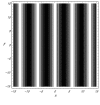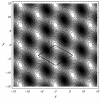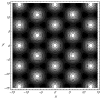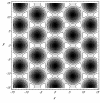Spatial turing-type pattern formation in a model of signal transduction involving membrane-based receptors coupled by g proteins
- PMID: 19458775
- PMCID: PMC2675512
Spatial turing-type pattern formation in a model of signal transduction involving membrane-based receptors coupled by g proteins
Abstract
In this paper, a model of signaling pathways involving G proteins is investigated. The model incorporates reaction-diffusion mechanisms in which various reactants participate inside and on the extra-cellular surface membrane. The messenger molecules may diffuse over the surface of the cell membrane and signal transduction across the cell membrane is mediated by membrane receptor bound proteins which connect the genetically controlled biochemical intra-cellular reactions to the production of the second messenger, leading to desired functional responses. Dynamic and steady-state properties of the model are then investigated through weakly nonlinear stability analysis. Turing-type patterns are shown to form robustly under different delineating conditions on the system parameters. The theoretical predictions are then discussed in the context of some recently reported experimental evidence.
Keywords: G proteins; Turing pattern; membrane based receptors; signal transduction; weakly nonlinear stability.
Figures





Similar articles
-
The role of trans-membrane signal transduction in turing-type cellular pattern formation.J Theor Biol. 2004 Feb 21;226(4):401-7. doi: 10.1016/j.jtbi.2003.09.018. J Theor Biol. 2004. PMID: 14759646
-
Linear and Weakly Nonlinear Stability Analyses of Turing Patterns for Diffusive Predator-Prey Systems in Freshwater Marsh Landscapes.Bull Math Biol. 2017 Mar;79(3):560-593. doi: 10.1007/s11538-017-0245-x. Epub 2017 Jan 30. Bull Math Biol. 2017. PMID: 28138877
-
Pattern formation in a coupled membrane-bulk reaction-diffusion model for intracellular polarization and oscillations.J Theor Biol. 2020 Jul 21;497:110242. doi: 10.1016/j.jtbi.2020.110242. Epub 2020 Mar 13. J Theor Biol. 2020. PMID: 32179107
-
An hypothesis: phosphorylation fields as the source of positional information and cell differentiation--(cAMP, ATP) as the universal morphogenetic Turing couple.Prog Biophys Mol Biol. 1991;56(2):79-105. doi: 10.1016/0079-6107(91)90015-k. Prog Biophys Mol Biol. 1991. PMID: 1658848 Review.
-
Integration and Spatial Organization of Signaling by G Protein-Coupled Receptor Homo- and Heterodimers.Biomolecules. 2021 Dec 3;11(12):1828. doi: 10.3390/biom11121828. Biomolecules. 2021. PMID: 34944469 Free PMC article. Review.
Cited by
-
Modeling Receptor Motility along Advecting Lipid Membranes.Membranes (Basel). 2022 Jun 25;12(7):652. doi: 10.3390/membranes12070652. Membranes (Basel). 2022. PMID: 35877855 Free PMC article. Review.
References
-
- Anderson R. The caveolae membrane system. Annu. Rev. Biochem. 1998;67:199–225. - PubMed
-
- Castets V, Dulos E, Boissonade J, De Kepper P. Experimental evidence of a sustained standing Turing-type nonequilibrium chemical pattern. Phys. Rev. Lett. 1990;64:2953–2956. - PubMed
-
- Erban R, Othmer HG. From signal transduction to spatial pattern formation in E.Coli: a paradigm for multiscale modeling in biology. Multiscale Model. Simul. 2005;3(2):362–394.
-
- Glansdorff P, Prigogine I. Thermodynamics theory of structure, stability and fluctuations. Wiley; London: 1971.
-
- Iglesias PA. Feedback control in intracellular signaling pathways: regulating chemotaxis in Dictyostelium discoideum. Europ. J. Contr. 2003;9:216–225.
LinkOut - more resources
Full Text Sources
